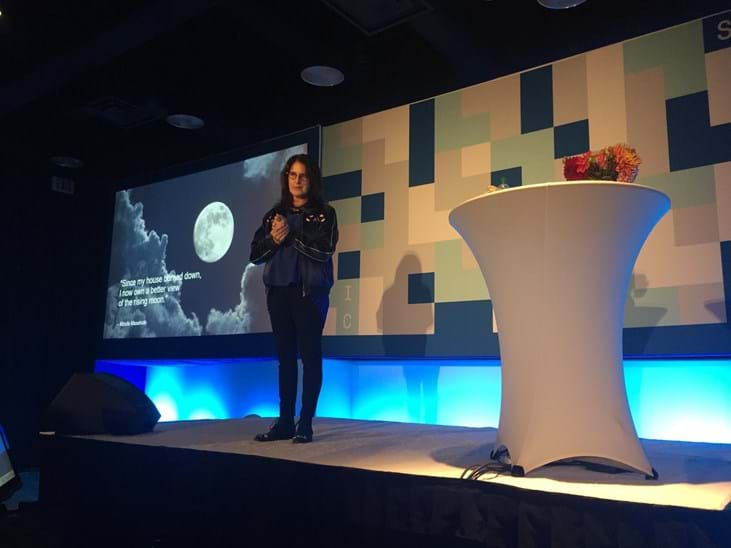
Mind the Gap: Conversation with Purpose
When I started at WE just 10 months ago, I kicked off my tenure with a challenge for my colleagues and myself: have more conversations.
That might seem strange coming from a GM/SVP of a communications firm. Our work depends on talking to each other, working together. But my point was how we interact can help us — or it can hurt us. And when I look at my inbox and my calendar, I have to wonder if all the emails and all the meetings are really helping. I wonder whether we’re hindering our ability to get to the “aha!” moments we crave as storytellers.
Because the truth is, WE pride ourselves on being storytellers — and we should. Even over the past few months, I’ve been inspired by what our people can do, how WE can bring stories to life for our clients. And after having the opportunity to work with our CEO, Melissa Waggener Zorkin, at this year’s Seattle Interactive Conference (SIC), I’ve never been so convinced about the role conversations play in cultivating the best storytelling.
During her keynote, Melissa spoke about the idea of a “story gap,” that space between truths and claims. Or as she put it, “the distance between understanding and misunderstanding.” And for better or worse, in today’s world, there’s huge opportunity for brands to help close those gaps.

WE believes that opportunity is for the better, and our Brands in Motion research backs that up. Consumers expect brands to help close the story gaps, so brands have a responsibility not only to take part in today’s social conversations, but also to offer solutions.
That means talking isn’t enough. Listening and acting need to be part of the storytelling. Put another way, the more a brand listens to its consumers — versus just talking at them — the better chance it has at identifying the gap between what it claims about itself versus how consumers view it. Once a gap is identified, a brand should take action to close it — or risk being dismissed.
Many of us are familiar with companies that reflect that logic, and they’re proving it pays. They show how identifying a story gap — and acting to address it — impacts their purpose, and in turn, their profit.
For example, brands like Patagonia, Toms and Warby Parker are doing more than just selling to or appeasing their customers. They’re listening, they’re having conversations and they’re putting their stories — their purpose — into motion.
It’s clear that these companies aren’t just talking about their purpose to help sell their products. They’re actively building their purpose and they recognize they can’t thrive without it. Purpose guides their actions, which dictate their narratives.
Like when Microsoft, one of our clients, took a stand for Dreamers and promised to pay the legal fees to protect the rights of its Dreamer employees. The decision was a reflection of how the company values diversity, opportunity and its employees, all of which map back to its purpose, mission and values. With that action, it was a brand in motion.
In a nutshell, companies that work to close their story gaps and put meaningful action behind their words show that doing good also means doing well. Brands that don’t are showing that there’s a real risk of falling through the cracks — or becoming stuck.
Two important parts of my job are to 1) understand that risk, and 2) foster an internal culture where our teams can convert that risk into opportunity — and ultimately, profit.
And I always come back to conversations. They allow us to do what emails and structured meetings can’t: have honest dialogue about what we’re doing and why. It’s through conversation that we most often find our purpose, then act to shape and own that purpose.
That’s how WE ended up at SIC. WE identified our own story gap and took action to close it. Instead of just talking at people about the importance of knowing their purpose, we leaned into our own — using the power of stories and conversation to move people into action.
WE joined one of our city’s best gatherings of creatives, businesses and local leaders, and we made a conscious effort to convene impactful conversations. At our #forwhichWEstand SIC meetups, we discussed issues facing our communities, how people and brands determine to take action, and ultimately, “to what end?”
We’re having those conversations with our clients, too, and it’s paying off. After all, how do you know what story to tell if you don’t know why you’re telling it? Yes, we’re awesome storytellers. But we’re also more than that. We’re listeners. We’re conversationalists. We’re purpose-finders.
When it comes to driving progress, WE covets conversations, both internally and with our clients. Because where WE purports to help our clients inspire action, we understand doing so requires listening, finding the story gap and working to close it. If you’re interested in exploring what it might look like to put your story in motion — and to what end — please feel free to reach out. We’d love to have a conversation with you.
Connect with the author on Twitter.
The latest blogs from WE
Decoding Gen Alpha: A Primer on the Next Gen of Consumers
Why Gen Alpha Will Fuel Spending This Season
Why Reputation Is a Business Driver in Healthcare


